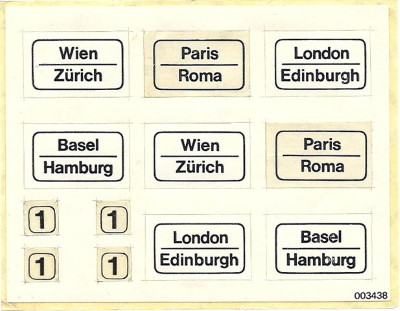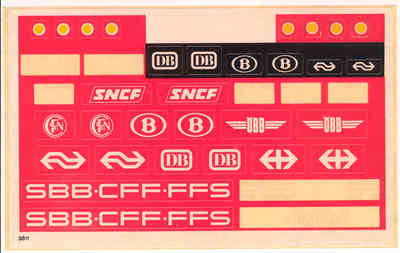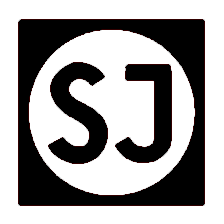The LEGO packaging, instructions and sticker sheets do not contain much written text. But the scraps of text they do contain allow us to catch a glimpse of the market that LEGO was targeting during the 1980s.
1970s (blue era)
1970s blue era train set 122 from 1969 was the first to feature a sticker. With set 131 from 1972, LEGO introduced the destination sign stickers. These destination signs indicate the start and endpoints of the train journey:

sticker sheet for set 131 from 1972
Set 727 from 1977 was the first to offer stickers for several European railroad companies: ÖBB (Austria), SNCF (France), B (Belgium), NS (the Netherlands), SBB-CFF-FFS (Switzerland) and DB (Germany).

sticker sheet for set 727 from 1977
Back then, LEGO must have mainly been targeting Germany, France, Switzerland and Austria, as these countries were present both in the destination signs and the railway company stickers. Other countries were present either as a destination sign (United Kingdom and Italy) or as a railway company (the Netherlands and Belgium). Note how by 1972, LEGO was already focusing more on the international market than on the market of its homeland Denmark.
1980s (grey era)
With the introduction of the grey era train sets in 1980, LEGO reassessed and expanded its market. The destination signs were carried over from the blue era, albeit scaled down and with one of them replaced. All passenger trains released in the 1980s featured these 4 destination signs:
| destination sign | places | countries |
 | Paris Rome | France Italy |
 | Brussels Amsterdam | Belgium The Netherlands |
 | Basel Hamburg | Switzerland Germany |
 | Vienna Zürich | Austria Switzerland |
Note how the London-Edinburgh sign from the blue era was replaced by Brussels-Amsterdam, favouring the Netherlands and Belgium over the United Kingdom. Also note the spelling error in 'Brussell', which should have read either 'Brussel' (Dutch) or 'Bruxelles' (French). This typo was corrected in sets 7715 and 7745, released in 1985.
The list of railway companies was expanded and updated to include the then-current logos of 12 western European railway companies:
| Logo | Country | Railway Company | Language |
| Germany | Deutsche Bahn (DB) | German | |
| Switzerland | Schweizerische Bundesbahnen (SBB) Chemins de Fer Fédéraux Suisses (CFF) Ferrovie Federali Svizzere (FFS) | German French Italian | |
| Netherlands | Nederlandse Spoorwegen (NS) | Dutch | |
| Belgium | Nationale Maatschappij der Belgische Spoorwegen (NMBS) Société Nationale des Chemins de fer Belges (SNCB) | Dutch French | |
| Denmark | Danske Statsbaner (DSB) | Danish | |
| Italy | Ferrovie dello Stato Italiane (FS) | Italian | |
| France | Société Nationale des Chemins de fer Français (SNCF) | French | |
| Austria | Österreichische Bundesbahnen (ÖBB) | German | |
 | Sweden | Statens Järnvägar (SJ) | Swedisch |
| United Kingdom | British Rail (BR) | English | |
 | Norway | Norges Statsbaner (NSB) | Norwegian |
 | Finland | Valtionrautatiet (VR) | Finnish |
For the grey era packaging design, LEGO started including texts on the sides of the boxes, indicating the intended minimal age for sets, usually 6 years for push-along and 4.5V trains and 8 years for 12V train sets. These were the languages LEGO included on every box (example) in 1980:
| year | age description | language |
| 1980 | Ab 8 Jahre | German |
| A partir de 8 ans | French | |
| Dai/Dagli 8 anni | Italian | |
| Vanaf 8 jaar | Dutch | |
| Fra 8 år | Danish Norwegian | |
| From 8 years | English | |
| Desde 8 años | Spanish | |
| 8-vuotiaista alkaen | Finnish | |
| Från 8 år | Swedish | |
| 1985 | Απὁ 8 χρονὡν | Greek |
| 1990 | 8歳から | Japanese |
| 八岁以上 | Chinese |
With the introduction of the 3rd wave of sets in 1985, LEGO started including Greek texts on boxes (example) and instructions. And in 1990, towards the end of the grey era, some boxes (example) even had Japanese and Chinese texts!
1980s LEGO market
From these lists, it is obvious that at the start of the 1980s, LEGO was targeting the western part of Europe. Remember that in the 1980s, the Iron Curtain was still a very big thing. Combining all data yields this map:

Countries in Europe that LEGO identified as their market during the 1980s
LEGOs main market consisted of the western European Countries: West Germany, France, Italy, Switzerland, Austria, The Netherlands and Belgium. These were the countries that were represented both by a travel destination (indicated on the map as black dots) and the logo of the national railway company. Of these countries, Germany must have been at the top of the list, as the designs of the trains were mostly inspired by German trains (like 7730 and 7740), and all pictures on boxes and instructions show the trains with the German DB stickers applied.
Secondly, LEGO targeted Scandinavia (Denmark itself, Norway, Sweden and Finland) and the United Kingdom. These were not included in the destination stickers, but did feature in the rail company stickers.
Based on the list of languages, LEGO was probably also targeting the markets of Spain, Ireland (English) and Luxembourg (French and German are featured in the language list, but not Luxembourgish). From 1985, Greece was included in this list. And LEGO was working towards a more global market in other ways as well, as the inclusion of English, French and Spanish also allowed export to the North and South Americas. By 1990, LEGO was expanding towards Japan and China.







